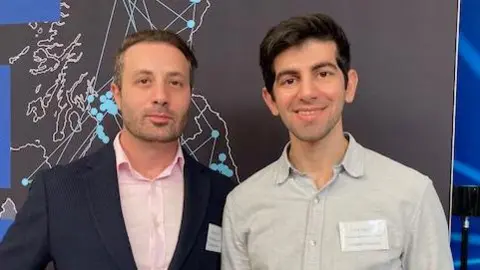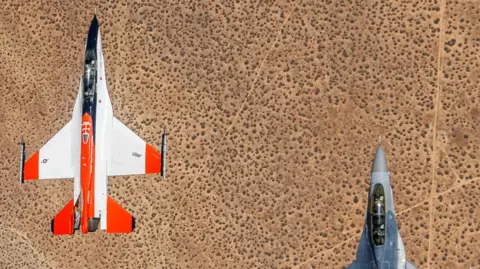Sci-Tech
What will future aerial dogfights look like?

By Michael Dempsey, Technology Reporter
 USAF
USAFI’m flying a Typhoon fighter over the Irish Sea and I’ve got a big problem.
There’s a hostile jet on my tail, and no matter how I push the joystick, or play with the throttle, this enemy is still there.
The threat is represented by a black triangle on the computer screen ahead of me that also displays a Typhoon cockpit. I’m in a series of three dogfights on a simulator and the results are not good.
That annoying little image won’t leave my six o’clock position, and I lose 3-0 to the ominous black triangle.
The ace I’m up against is an AI dogfighter developed by Turkish aerospace engineers commissioned by defence giant BAE Systems.
They’ve been working on an AI co-pilot that could save a real life aviator in a dogfight, and will find its way into sophisticated warfighting simulators.
One of the engineers, Emre Saldiran, is studying at Cranfield University in the UK, which has strong aerospace links. He describes how the AI co-pilot picked up fighting tactics by a process of trial and error. “We reinforce the AI’s learning with more and more data put into the dogfight simulator.”
One of his objectives is to address the information overload fighter pilots endure. His colleague Mevlϋt Uzun assures me that AI takes a lot of learning to beat humans. “The AI made millions of mistakes. Teaching it is like guiding a child.”
But once trained the AI can offer valuable advice, according to Mr Uzun.
“The AI can tell a pilot to slow down or speed up. And it can evaluate an emerging dogfight and warn of a 70% probability the pilot will lose if they get into that fight.”
So the AI warns pilots of situations likely to end in their jet being shot down and it takes that decision in milliseconds. But the design team aren’t making any big claims about it replacing a pilot.
“It’s just a piece of code, you could run it on your phone,” says Mr Uzun. Today their program is running off a normal laptop PC.

The US Air Force revealed its own, rather more elaborate, AI dogfighter in 2023. It was demonstrated flying an F-16 jet in combat manoeuvres.
This flight was the culmination of years of work aimed at creating an AI that could beat a living pilot.
Eight US AI companies went head to head in 2020 during a three-day competition known as the AlphaDogfight Trials Event. This involved simulated online dogfights between the competing AI programs and an experienced USAF fighter pilot.
The winning program beat the pilot repeatedly, and Brett Darcy of US defence shop Shield AI was on the three-strong team that built it.
He remembers the AlphaDogfight event vividly. “The competitors ranged from the big boys like [defence giant] Lockheed Martin down to us.”
They started out by pitching their AI pilot against a target flying straight and level, “a sitting duck” says Mr Darcy.
They progressed to fighting other AI pilots, getting the AI to think about tactics. Certain rules, such as the length of each dogfight (usually five minutes) and the maximum speed they could attain were set.
But there was no requirement to abide by USAF doctrine. “Our AI used a head-on merge with the target as an opportunity to fire guns,” he says.
This novel tactic went against accepted air fighting doctrine. The AI had learned to reject rules when it could spot a better move.
Points were awarded with each combat, the AI evolving to match successful outcomes. Multiple copies of the AI were generated by this evolution as the competing AI pilots measured up to each other’s changing tactics.
These heats left Mr Darcy’s group to oppose an experienced USAF fighter pilot wearing a VR headset that put him in the cockpit of an F-16.
Thanks to victories scored against that human pilot, Mr Darcy’s small team was invited into the government’s Defense Advanced Research Projects Agency (Darpa), which develops technology for the US Department of Defense.
Specifically, they joined Darpa’s Air Combat Evolution (ACE) project.
When Darpa’s AI-driven F-16 took to the air it was controlled during combat by a distant descendant of the software Mr Darcy’s team wrote in 2020.
AI evolves at a startling pace. Mr Darcy says this was “a many times removed grandson of the AlphaDogfighter AI.”
Despite a bewildering rate of development AI has a long way to go. The ACE jet has a safety pilot on board for take-off and landing who can switch off the AI at any time.
 USAF
USAFFor an AI pilot to be effective it has to win a lot of trust and be able to integrate into wider forces around it.
Intriguingly Mr Darcy says a big question is how an AI pilot can “explain itself on the ground”, debriefing human controllers on its actions and motives.
The UK AI dogfighter is very thrifty compared to its US cousin. “They are teaching the AI to fly an aircraft” says Dr Uzun. “We don’t need to do that.”
Paring the project down by concentrating on combat moves alone meant the Cranfield team worked fast. “What they took weeks to do we did in two days.”
One man whose career spans the rise of digital defence tools is Michael Hull. Now a principal technologist at BAE Systems in Warton, Lancashire, he joined the business as an apprentice electronics engineer in 1990.
Dramatic changes he has witnessed, include the way innovations that once emerged from inside defence companies now travel in the other direction. “We pull technology like AI into defence from the public domain.”
So, the AI dogfighter’s frugal heritage includes air-to-air combat tactics downloaded from Wikipedia, leaving classified information well out of the picture and contributing to the pace of the project.
 Mick Hull
Mick HullHow did the quick assembly British AI dogfighter fare against a real Top Gun?
Ben Westoby-Brooks flew Typhoons for the RAF and works for BAE Systems. He went up against the AI dogfighter and defeated it.
The AI dogfighter is no substitute for thousands of hours flying fast jets in very demanding circumstances. But it feeds into realistic online combat exercises and could reduce pilot overload in a genuine cockpit.
Sci-Tech
Cristiano Ronaldo first to hit 1bn social media followers

Cristiano Ronaldo has hit 1bn total followers across his various social media accounts – making him the first person to reach that mind-boggling figure.
The number is calculated by combining his total number of followers across Instagram, Facebook, Twitter, YouTube, and Chinese social media sites Weibo and Kuaishou.
It does not equate to one billion individual followers, as many people will follow him across multiple platforms, and some will be fake accounts, known as bots.
Nonetheless social media expert Paolo Pescatore, from PP Foresight, described it as a “staggering number” that media and brands would pay close attention to.
“What an achievement, and it further underlines the fundamental shift taking place in media.”
It showed “the power to reach new, younger audiences thanks to technology”, he told the BBC.
On the pitch, Ronaldo was famed for his rivalry with Argentinian star Lionel Messi.
But off it, there is no competition for who is winning the social media contest – Messi has a mere 623 million followers.
Some of the other celebrities with the biggest presence on social media are:
- 690m: Selena Gomez, actor/singer
- 607m: Justin Bieber, singer
- 574m: Taylor Swift, singer
Other notable names the BBC looked into include The Rock (557m), Kylie Jenner (551m ) and Ariana Grande (508m).
MrBeast, the top YouTuber in the world, has 543m total followers, while WWE, often considered to have an enormous social media presence, can only point to reaching a quarter of the audience of Cristiano Ronaldo with 268m combined followers.
The footballer will have reached this milestone thanks to his decision to join YouTube last month, where his channel rocketed to 50 million subscribers within a single week.
So far, the channel consists mainly of conversations between Ronaldo and his wife Georgina Rodríguez, as well as his former Manchester United colleague Rio Ferdinand.
He announced the news in a post shared across his various social media platforms.
Cristiano Ronaldo has made a career out of breaking records.
His successes include being top scorer in Uefa Champions League history, having the most goals in the European Championship, and making more international appearances than anyone else.
Last week he became the first footballer to score 900 top-level career goals.
As with his playing career, he still has scope to improve his numbers on social media too, as unlike some of his rivals, he is not on TikTok or Threads.
All of which is likely to add to another figure he dominates: earnings.
According to Forbes, his total earnings now stand at $260 million – the highest of any athlete.
Sci-Tech
Musk and Zuckerberg have ‘polluted culture’

Meta boss Mark Zuckerberg and X owner Elon Musk are “the worst polluters in human history”, Stephen Fry has said.
The actor and comedian made the claim during a lecture at Kings College, London.
“You and your children cannot breathe the air or swim in the waters of our culture without breathing in the toxic particulates and stinking effluvia that belch and pour unchecked from their companies into the currents of our world,” he said of the pair.
The BBC has approached the two men’s companies for comment.
Mr Fry has a track record of being an early adopter of technology – and was once a regular poster on X, when it was known as Twitter.
He stopped posting in 2022, a few months after the platform was purchased by Mr Musk, but has retained his account. He is no longer active on any social networks.
“I’m the chump who thought social media could change the world,” he told his audience at the Digital Futures Institute.
He said he was at first enthusiastic about the potential of social media to unite people around the world and bring about positive change in society, citing the Arab Spring protests which were coordinated online as an example – but added that he had been proved wrong.
He described what he considered to be a fatal flaw in attempts by early Facebook algorithms to “maximise engagement”, saying nobody had predicted that engagement would be “most maximised by… the worst passions” such as anger, shock and horror.
“We are decidedly hopeless at knowing where technology will take us or what it will do to us,” he said.
He returned to the theme several times throughout his one hour speech, in which he also considered the future of artificial intelligence.
Mr Fry argued that AI was “poised to disrupt every space we have”.
He said he hoped corporate greed would not corrupt the development of AI tech at the expense of safety.
“The best I can do is this – Einstein and Russell said in their manifesto on nuclear weapons – we appeal as human beings to human beings, remember your humanity and forget the rest,” he said.
Mr Fry’s broadside was not the only attack on Mr Musk.
Earlier on Thursday, senior Meta executive Sir Nick Clegg, talking at Chatham House, in London, had been similarly scathing of Mr Musk’s platform X.
The former deputy prime minister called it “a tiny, elite, news-obsessed, politics-obsessed app” and added that in his view the social network had become “a one-man hyper-partisan hobby horse.”
In March 2024 X claimed to have 550 million monthly visitors. Facebook has just over 3bn.
Additional reporting by Liv McMahon
Sci-Tech
Vodafone clashes with UK’s competition watchdog over Three merger

Vodafone and Three have rejected claims by the UK’s competition watchdog that their proposed merger would lead to higher prices for millions of mobile users.
The Competition and Markets Authority (CMA) has “provisionally concluded” the deal would weaken competition between mobile networks.
It has particular concerns that customers who are least able to afford mobile services would be most affected.
The findings are the latest from the CMA’s ongoing probe into the merger, which it launched in January.
The regulator will now consult on its findings and potential solutions to its worries over competition.
These solutions could include legally binding investment commitments, and measures to protect both retail and wholesale customers.
Vodafone’s CEO for European Markets, Ahmed Essam, told the Today programme, on BBC Radio 4, that he still believed the merger would make a better network for customers, and add to the competition in the market.
“We’ve made a significant commitment to an £11bn investment,” he said.
“We’re willing to make sure that this is legally binding, and we undertake a commitment to deploy this.”
He also said the firm had already traded part of its radio spectrum with a competitor.
But the CMA said it is “not convinced” that it would be good for consumers.
“The main knockback to the merging parties is that the CMA considers claims of superior network quality post integration to be “overstated”,” said Kester Mann from analysis firm CCS Insight.
But he said the regulator was not shutting the door on the deal.
“Vodafone and Three should be encouraged by the tone of the CMA’s report, which appears more open to the merger than I was expecting.”
But Rocio Concha, director of policy and advocacy at consumer group Which?, took a different view.
“The regulator’s finding has set a high bar for the merger to proceed,” she said.
“It is clear from those findings that the planned merger between Vodafone and Three could have a negative impact on millions of consumers.”
But she warned it would be “challenging” for the regulator to find remedies for its concerns.
Vodafone and Three revealed plans to merge their UK-based operations in June last year, creating the biggest mobile network in the UK with around 27 million customers.
But the CMA provisionally concluded on Wednesday that such a deal would lead to a “substantial lessening in competition”.
In addition to worries over price and service levels, the regulator is also concerned that the deal may make it more difficult for smaller players such as Lyca Mobile, Sky Mobile and Lebara – who rent space from the bigger operators – to get a good deal.
Vodafone and Three have said the tie-up would lead to an additional investment of £11bn in the UK.
The CMA found that a merger of the two could improve the quality of mobile networks and accelerate next generation 5G networks and services, as claimed by the companies.
But it considered these claims were “overstated”, and that the merged firm would not necessarily have the incentive to carry out planned investment after the merger.
In a statement, Vodafone and Three said they disagreed with the CMA’s findings.
“By all measures, the merger is pro-growth, pro-customer and pro-competition. It can, and should, be approved by the CMA,” they said.
The CMA will issue a final report into the deal in December.
The firms added they would be working with the regulator to secure approval for the tie-up.
-

 African History5 years ago
African History5 years agoA Closer Look: Afro-Mexicans 🇲🇽
-

 African History8 months ago
African History8 months agoBlack History Facts I had to Learn on My Own pt.6 📜
-

 African History5 years ago
African History5 years agoA Closer Look: Afro-Mexicans 🇲🇽
-

 African History1 year ago
African History1 year agoMajor African Tribes taken away during the Atlantic Slave Trade🌍 #slavetrade #africanamericanhistory
-

 African History1 year ago
African History1 year agoCameroon 🇨🇲 World Cup History (1962-2022) #football #realmadrid #shorts
-

 African History1 year ago
African History1 year agoWhat did Columbus Find in 1493? 🤯🔥🔥 #history #civilization #mesoamerica #africa #kemet
-

 African History8 months ago
African History8 months agoBlack History Inventors: Mary Kenner 🩸
-

 African History1 year ago
African History1 year agoOrigin Of ‘Cameroon’ 🇨🇲😳#africa

























